 W
WFashion in the period 1600–1650 in Western European clothing is characterized by the disappearance of the ruff in favour of broad lace or linen collars. Waistlines rose through the period for both men and women. Other notable fashions included full, slashed sleeves and tall or broad hats with brims. For men, hose disappeared in favour of breeches.
 W
WFashion in the period 1650–1700 in Western European clothing is characterized by rapid change. The style of this era is known as Baroque. Following the end of the Thirty Years' War and the Restoration of England's Charles II, military influences in men's clothing were replaced by a brief period of decorative exuberance which then sobered into the coat, waistcoat and breeches costume that would reign for the next century and a half. In the normal cycle of fashion, the broad, high-waisted silhouette of the previous period was replaced by a long, lean line with a low waist for both men and women. This period also marked the rise of the periwig as an essential item of men's fashion.
 W
WA beaver hat is a hat made from felted beaver fur. They were fashionable across much of Europe during the period 1550–1850 because the soft yet resilient material could be easily combed to make a variety of hat shapes. Smaller hats made of beaver were sometimes called beaverkins, as in Thomas Carlyle's description of his wife as a child.
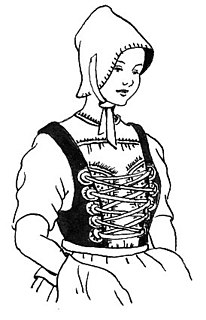 W
WA bodice is an article of clothing for women and girls, covering the torso from the neck to the waist. The term typically refers to a specific type of upper garment common in Europe during the 16th to the 18th century, or to the upper portion of a modern dress to distinguish it from the skirt and sleeves. The name bodice comes from an older garment called a pair of bodies.
 W
WThe bow tie is a type of necktie. A modern bow tie is tied using a common shoelace knot, which is also called the bow knot for that reason. It consists of a ribbon of fabric tied around the collar of a shirt in a symmetrical manner, so that the two opposite ends form loops.
 W
WThe boyar hat was a fur hat worn by Russian nobility between the 15th and 17th centuries, most notably by boyars, for whom it was a sign of their social status. The higher hat indicated the higher status.
 W
WA capotain, capatain or copotain is a tall-crowned, narrow-brimmed, slightly conical "sugarloaf" hat, usually black, worn by men and women from the 1590s into the mid-seventeenth century in England and northwestern Europe. Earlier capotains had rounded crowns; later, the crown was flat at the top.
 W
WA cavalier hat is a variety of wide-brimmed hat popular in the seventeenth century. These hats were often made from felt, and usually trimmed with an ostrich plume. They were often cocked up or had one side of the brim pinned to the side of the crown of the hat which was then decorated with feathers.
 W
WA changshan is a traditional Manchu dress worn by men. In function, it is considered the male equivalent of the women's cheongsam (qipao). It is also known as a changpao or dagua. It was often worn by men with a magua or "riding jacket". These types of dress were widely adopted beginning under the Manchu rulers of the Qing dynasty, who required that men in certain positions wear this style.
 W
WA chastity belt is a locking item of clothing designed to prevent sexual intercourse or masturbation. Such belts were historically designed for women, ostensibly for the purpose of chastity, to protect women from rape or to dissuade women and their potential sexual partners from sexual temptation. Modern versions of the chastity belt are predominantly, but not exclusively, used in the BDSM community, and chastity belts are now designed for male wearers in addition to female wearers.
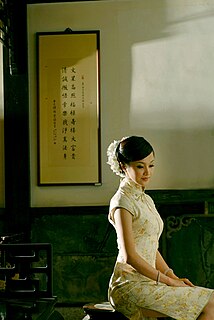 W
WThe cheongsam, also known as the qipao, is a type of body-hugging dress of Manchu origin. It is a high-necked, closefitting dress with the skirt slit partway up the side. It was known as the mandarin gown during the 1920s and 1930s, when it was modernized by Chinese socialites and upper-class women in Shanghai.
 W
WA corset is a support garment commonly worn to hold and train the torso into a desired shape, traditionally a smaller waist or larger bottom, for aesthetic or medical purposes, or support the breasts. Both men and women are known to wear corsets, though this item was for many years an integral part of women's wardrobes.
 W
WThe corset has been an indispensable supportive undergarment for women, in Europe for several centuries, evolving as fashion trends have changed and being known, depending on era and geography, as bodies, stays and corsets. The appearance of the garment represented a change from people wearing clothes to fit their bodies to changing the shape of their bodies to fit their fashionable clothing.
 W
WThe cravat is a neckband, the forerunner of the modern tailored necktie and bow tie, originating from a style worn by members of the 17th century military unit known as the Croats. The modern British "cravat" is called an ascot in American English.
 W
WA doublet is a man's snug-fitting jacket that is shaped and fitted to the man's body which was worn in Spain and was spread to Western Europe from the late Middle Ages up to the mid-17th century. The doublet was hip length or waist length and worn over the shirt or drawers. Until the end of the 15th century, the doublet was usually worn under another layer of clothing such as a gown, mantle, overtunic or jerkin when in public.
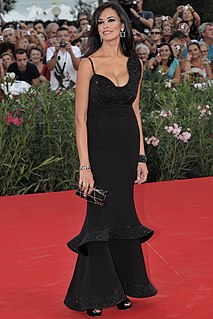 W
WAn evening gown, evening dress or gown is a long dress usually worn at formal occasions. The drop ranges from ballerina, tea, to full-length. Such gowns are typically worn with a evening gloves. Evening gowns are usually made of luxurious fabrics such as chiffon, velvet, satin, organza, etc. Silk is a popular fibre for many evening gowns. Although the terms are used interchangeably, ball gowns and evening gowns differ in that a ball gown will always have a full skirt and a fitted bodice, while an evening gown can be any silhouette—sheath, mermaid, A-line, or trumpet shaped—and may have straps, halters or even sleeves.
 W
WFarshi Pajama is a woman's dress that was worn between early 20th centuries in Muslim courts of Oudh by royalty and ladies from privileged classes of Uttar Pradesh. Modeled after the flowing gowns worn by British noblewomen, the complete outfit consists of three basic parts – the kurta or a long shirt, the dupatta or the long stole, and the third and most important, the farshi pajama, which is a flowing two-legged skirt held by drawstrings. It falls straight to the ankles from where it starts flaring flowing copiously onto the floor. The farshi pajama in this era is often called Farshi Gharara, a term not used before the mid-20th century and is considered a distortion. The confusion is said to be because of the Farshi Pajama's similarity with the Gharara.
 W
WA farthingale is one of several structures used under Western European women's clothing in the 16th and 17th centuries to support the skirts in the desired shape and enlarge the lower half of the body. It originated in Spain in the fifteenth century. Farthingales served important social and cultural functions for women in Renaissance Europe as they were used, primarily by court women, to show their high social position and wealth. This is because these structures increased the amount of expensive fabrics used in the gowns that covered them.
 W
WA fontange, or frelange, is a high headdress popular during the turn of the late 17th and early 18th centuries in Europe. Technically, fontanges are only part of the assembly, referring to the ribbon bows which support the frelange. The frelange was supported by a wire framework called a commode. A surviving example of a frelange headdress with fontanges and commode in situ is that worn by the 1690s fashion doll Lady Clapham. In England, the style was popularly known as a 'top-knot', versions of which were worn by ladies of all ranks, from the Queen downwards to kitchen maids, making it an easy target for satire and criticism.
 W
WFop became a pejorative term for a foolish man excessively concerned with his appearance and clothes in 17th century England. Some of the many similar alternative terms are: coxcomb, fribble, popinjay or dandy, fashion-monger, and ninny. Macaroni was another term of the 18th century more specifically concerned with fashion.
 W
WFrock has been used since Middle English as the name for an article of clothing, typically coat-like, for men and women.
 W
WA gown, from the Saxon word, gunna, is a usually loose outer garment from knee- to full-length worn by men and women in Europe from the Early Middle Ages to the 17th century, and continuing today in certain professions; later, gown was applied to any full-length woman's garment consisting of a bodice and attached skirt. A long, loosely fitted gown called a Banyan was worn by men in the 18th century as an informal coat.
 W
WA greatcoat, also known as a watchcoat, is a large overcoat that is typically made of wool designed for warmth and protection against the weather. Its collar and cuffs can be turned out to protect the face and hands from cold and rain, and the short cape around the shoulders provides extra warmth and repels rainwater. During the 17th and 18th centuries and the Industrial Revolution, greatcoats became available for all social classes. It was popular in the 19th century as a military uniform and casual wear for the wealthy, and is still issued for inclement weather by many armed forces around the world.
 W
WA hoop skirt or hoopskirt is a women's undergarment worn in various periods to hold the skirt extended into a fashionable shape.
 W
WHose are any of various styles of men's clothing for the legs and lower body, worn from the Middle Ages through the 17th century, when the style fell out of use in favour of breeches and stockings. The old plural form of "hose" was "hosen". In German these terms remained in use and are the generic terms for trousers today. The French equivalent was chausses.
 W
WA jerkin is a man's short close-fitting jacket, made usually of light-coloured leather, and often without sleeves, worn over the doublet in the sixteenth and seventeenth centuries. The term is also applied to a similar sleeveless garment worn by the British Army in the 20th century.
 W
WThe jewels of Anne of Denmark (1572–1619), wife of James VI and I and queen consort of Scotland and England, are known from accounts and inventories, and their depiction in portraits by artists including Paul van Somer. A few pieces survive. Modern historians prefer the name "Anna" to "Anne", following the spelling of numerous examples of her signature.
 W
WJewels belonging to Arbella Stuart were noted in several lists. They include jewels which she inherited from her grandmother, Margaret Douglas, Countess of Lennox, which were taken to Scotland by her mother's executor.
 W
WA justacorps or justaucorps is a long, knee-length coat worn by men in the latter half of the 17th century and throughout the 18th century. The garment is of French origin, and was introduced in England as a component of a three-piece ensemble, which also included breeches and a long vest or waistcoat. This ensemble served as the prototype of the frock coat, which in turn evolved into the modern-day three-piece suit.
 W
WThe kokoshnik is a traditional Russian headdress worn by women and girls to accompany the sarafan. The kokoshnik tradition has existed since the 10th century in the ancient Russian city Veliky Novgorod. It spread primarily in the northern regions of Russia and was very popular from 16th to 19th century. It is still to this day an important feature of Russian dance ensembles and folk culture and inspired the Kokoshnik style of architecture.
 W
WThe magua was a style of jacket worn by males during the Chinese Qing dynasty (1644–1911), designed to be worn together with and over the manshi changshan (滿式長衫). Magua is at waist length, with five disc buttons on the front and slightly short, wide sleeves. The garment was available in a number of styles: singlet, clip, leather, cotton yarn quilted and others. It was worn by Manchu people throughout China from the reign of the Qing Shunzhi Emperor until the time of the Kangxi Emperor,, whence it became popular throughout Qing China.
 W
WManchu platform shoes refers to two styles of traditional Manchu women's high platform shoes which appeared in the early Qing dynasty and continued to be worn even in the late Qing dynasty. Depending on its shape, it could be classified as:Huapen xie, also known as huapen di, huapen dixie, or commonly referred as 'flowerpot shoes' in English, and Mati xie, Mati dixie, or commonly referred as 'horse hoof-tread shoes' or 'horse hoof shoes' in English.
 W
WA mantua is an article of women's clothing worn in the late 17th century and 18th century. Originally a loose gown, the later mantua was an overgown or robe typically worn over stays, stomacher and a co-ordinating petticoat.
 W
WA mantua from the collection at Kimberley Hall in Norfolk is the earliest complete European women's costume in the Costume Institute of the Metropolitan Museum of Art in New York. Also known as the Kimberley Gown, this formal dress is a mantua, a two-piece costume consisting of a draped open robe and a matching underskirt or petticoat, and has been dated to ca. 1690–1700.
 W
WMargaret Layton's jacket is a surviving example of English Jacobean embroidery, significant because it appears in a portrait which has also survived. The jacket was originally owned and worn by Margaret Layton (1579–1641), wife of Francis Layton (1577–1661) who was one of the Yeomen of the Jewel House during the reigns of James I, Charles I and, briefly, Charles II. Embroidered linen jackets were worn as informal dress, and were particularly popular among wealthy women in the late sixteenth and early seventeenth centuries. This jacket is exquisitely decorated with flowers, birds and butterflies, embroidered in coloured silks, coiled tendrils of silver-gilt plaited braid stitch and silver-gilt sequins. The edges of the jacket are trimmed with silver and silver-gilt bobbin lace and silver-gilt spangles.
 W
WThe Monmouth cap was an item of woollen headgear fashionable between the 15th and 18th centuries, and associated with the town of Monmouth in South East Wales. The knitted round caps were used by both soldiers and sailors, and they were widely exported.
 W
WOver-the-knee boots, OTK boots, are long boots that fully or partly cover the knee. Originally created as a man's riding boot in the 15th century, in the latter part of the 20th century, the style was redefined as a fashion boot for women. Over-the-knee boots are also used as a work boot in circumstances requiring additional protection for the legs.
 W
WPaisley or paisley pattern is an ornamental textile design using the boteh or buta, a teardrop-shaped motif with a curved upper end. Of Persian origin, paisley designs became popular in the West in the 18th and 19th centuries, following imports of post–Mughal Empire versions of the design from India, especially in the form of Kashmir shawls, and were then replicated locally.
 W
WPanniers or side hoops are women's undergarments worn in the 17th and 18th centuries to extend the width of the skirts at the side while leaving the front and back relatively flat. This provided a panel where woven patterns, elaborate decorations and rich embroidery could be displayed and fully appreciated.
 W
WA peascod belly is a type of exaggeratedly padded stomach that was very popular in men's dress in the late 16th and early 17th centuries. The term is thought to have come from "peacock," or from the form of contemporary plate armour. Sometimes it was called a 'goose belly.'
 W
WA pelisse was originally a short fur trimmed jacket that was usually worn hanging loose over the left shoulder of hussar light cavalry soldiers, ostensibly to prevent sword cuts. The name was also applied to a fashionable style of woman's coat worn in the early 19th century.
 W
WA petticoat or underskirt is an article of clothing, a type of undergarment worn under a skirt or a dress. Its precise meaning varies over centuries and between countries.
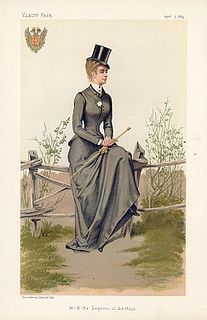 W
WA riding habit is women's clothing for horseback riding.
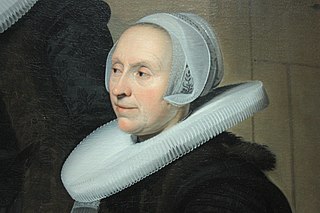 W
WA ruff is an item of clothing worn in Western, Central, and Northern Europe from the mid-16th century to the mid-17th century. The round and flat variation is often called a millstone collar after its resemblance to millstones for grinding grain.
 W
WA sabot is a clog from France or surrounding countries such as The Netherlands, Belgium or Italy. Sabots are either whole-foot clogs or a heavy leather shoe with a wooden sole.
 W
WA sarafan is a long, trapezoidal Russian jumper dress worn by girls and women and forming part of Russian traditional folk costume.
 W
WShoe buckles are fashion accessories worn by men and women from the mid-17th century through the 18th century to the 19th century. Shoe buckles were made of a variety of materials including brass, steel, silver or silver gilt, and buckles for formal wear were set with diamonds, quartz or imitation jewels.
 W
WA supportasse or underpropper is a stiffened support for a ruff or collar. Essential items of courtly fashion in the late 16th and early 17th centuries, supportasses are sometimes called piccadills, whisks, or rebatos, terms used at different times for both the supporters and the various lace or linen collar styles to which they were attached.I pray you, sir, what say you to these great ruffs, which are borne up with supporters and rebatoes, as it were with post and rail?
 W
WA swimsuit is an item of clothing designed to be worn by people engaging in a water-based activity or water sports, such as swimming, diving and surfing, or sun-orientated activities, such as sun bathing. Different types may be worn by men, women, and children. A swimsuit can be described by various names, some of which are used only in particular locations, including swimwear, bathing suit, swimming costume, bathing costume, swimming suit, swimmers, swimming togs, bathers, cossie, or swimming trunks for men, besides others.
 W
WThe tricorne or tricorn is a style of hat that was popular during the 18th century, falling out of style by 1800, though actually not called a "tricorne" until the mid-19th century. During the 18th century, hats of this general style were referred to as "cocked hats". At the peak of its popularity, the tricorne varied greatly in style and size, and was worn not only by the aristocracy, but also as common civilian dress, and as part of military and naval uniforms. Typically made from animal fiber, the more expensive being of beaver-hair felt and the less expensive of wool felt, the hat's most distinguishing characteristic was that three sides of the brim were turned up (cocked) and either pinned, laced, or buttoned in place to form a triangle around the crown. The style served two purposes: first, it allowed stylish gentlemen to show off the most current fashions of their wigs, and thus their social status; and secondly, the cocked hat, with its folded brim, was much smaller than other hats, and therefore could be more easily tucked under an arm when going inside a building, where social etiquette dictated that a gentleman should remove his hat. Tricornes with laced sides could have the laces loosened and the sides dropped down to provide better protection from the weather, sun, and rain.
 W
WUndergraduate gowns are a notable feature of academic dress for students at the ancient universities in Scotland.
 W
WA virago sleeve is a women's item of clothing fashionable in the 1620s–1630s. It is a full "paned" or "pansied" sleeve gathered into two puffs by a ribbon or fabric band above the elbow.
 W
WA visard is an oval mask of black velvet, worn by travelling women in the 16th century to protect their skin from sunburn. It was not held to the head by a fastening, but rather the wearer would clasp a bead attached to the interior of the mask between their teeth. The fashion of the period for wealthy women was to keep their skin pale, because a tan suggested that the bearer worked outside and was hence poor.
 W
WA vlieger is a type of sleeveless over-gown or cape worn by women in the late 16th and early 17th-centuries. Variations with short sleeves or high shoulder rolls are known. Sometimes sleeves were attached with aiglets, and often slits were made to allow belts or the hands to pass through.
 W
WA waistcoat, or vest (US), is a sleeveless upper-body garment. It is usually worn over a dress shirt and necktie and below a coat as a part of most men's formal wear. It is also sported as the third piece in the traditional three-piece male suit. Any given vest can be simple or ornate, or for leisure or luxury. Historically, the vest can be worn either in the place of or underneath a larger coat dependent upon the weather, wearer, and setting.